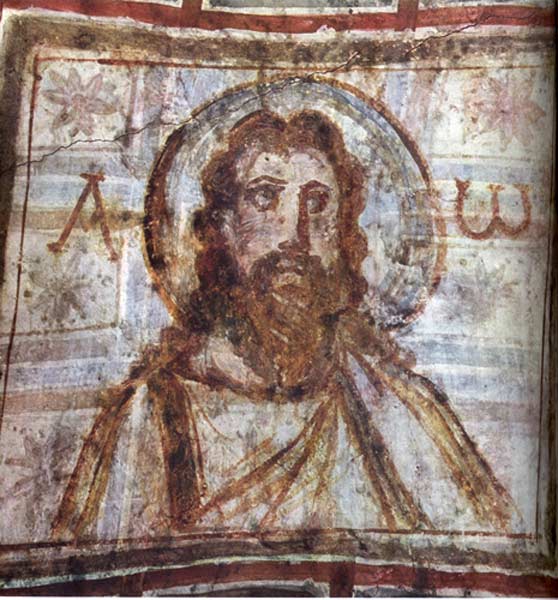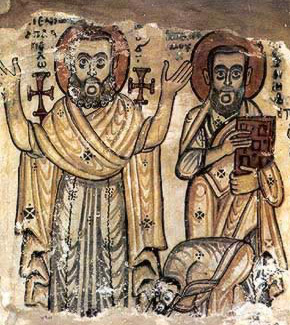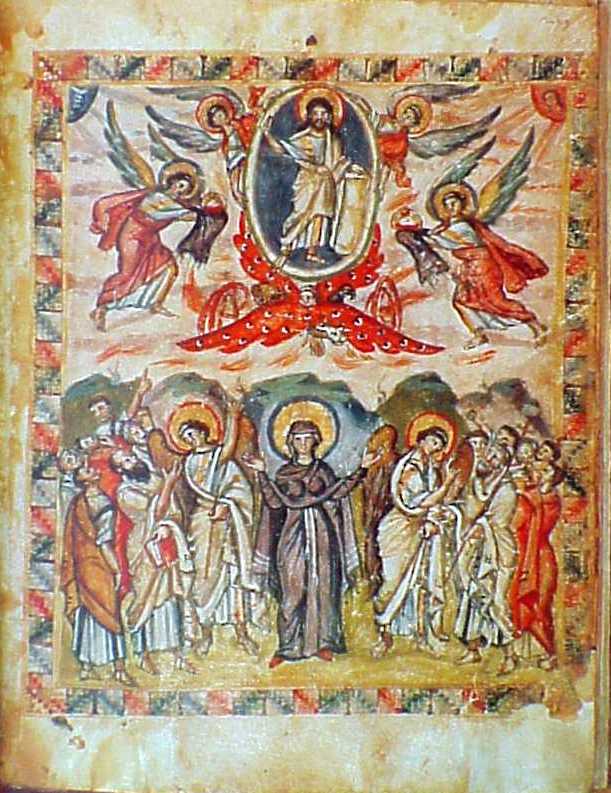- Apr 6, 2018
- 7,356
- 5,235
- 25
- Country
- United States
- Faith
- Eastern Orthodox
- Marital Status
- Single
We can see here a Jewish synagogue with images.The Talmud? No, why?
I will simply ask the pastors I know who are Hebrew scholars.
Upvote
0
We can see here a Jewish synagogue with images.The Talmud? No, why?
I will simply ask the pastors I know who are Hebrew scholars.
Why? Because they are images or because they would be worshipped as gods?Exodus 20:4-5 specifically forbids bowing down to carved images or manufactured likenesses.
Why? Because they are images or because they would be worshipped as gods?
We can see here a Jewish synagogue with images.
View attachment 250922
How so?



Iconoclasm began in Constantinople in the early 8th century. I don't think it was the result of Islamic influence.
I have a question for all of the iconoclasts in this thread: Do you have some kind of objection to the incarnation of Jesus Christ, the Word of God? Because scripture literally calls Him "The image of the invisible God" (Colossians 1:15), and in the original it is using the same word from which we get the English word 'icon' (εἰκὼν eikon) to signify that.
If it is wrong to 'worship' images ... and Christ is literally the image of the invisible God, is it wrong to worship Christ? Is it wrong that Christ is visible?
I'm going to assume that the answer to both of those is no, it is not wrong, and furthermore Christ is God, so the comparison does not hold. That's just it, though: icons are a testament to Christ's incarnation -- His literal, fleshly reality; that He was truly incarnate as an actually-existing man, in the real world in which we all live. And so to be against icons is at least an implicit denial of His incarnation.
And so to be against icons is at least an implicit denial of His incarnation.
And if you for some reason would therefore not be against icons of Christ, but instead be against icons of any of the saints, the same is applicable because to deny proper veneration to those people, places, and things that He has personally resided within is to likewise deny His actual existing and effective working within the world. He is then a kind of phantasm, perhaps existing, yes, but having no true effect. If no saint is to be venerated because they are but sinful human beings (which, again, no one who venerates a saint whether using an icon or not would deny, but anyway...), then no one is truly Christ-like, as Christ's coming did not actually transform and redeem mankind, but perhaps only open the door that it may be done in the future (say on the last day or in the afterlife or whatever). There is a way in which we (Orthodox Christians) can agree with this, in that the process of Theosis is eternal and continues on into eternity, but even then it begins here, in the holy saints who have pleased God since the beginning, and in all of us likewise who have put on Christ in baptism.
You conclude with one more fallacy, the always popular "straw man". You've set up your summary so that a denial of icons is a denial of the incarnation. Since no Christian denies that Christ came in the flesh this paragraph is incoherent.So you see how iconoclasm touches so many other central points of the Christian life beyond whether or not any individual is personally comfortable with or preferring this type of material worship over some other type. Surely God could have saved us by whatever means He saw fit, and yet the means He actually chose and underwent of His own will (to take the form of a servant and come to us on earth) are not arbitrary nor up to us to reject because we have different ideas of what monotheism is than God does based on whatever (our individualistic readings of the OT or NT, our personal sense of what 'idolatry' is, etc).
Iconoclasm was a reaction toward what appeared to be God favoring another political power over Rome, and thus in order to regain God's political favor one needed to do away with the images
to be more like the guys who were winning.
the Second Council of Nicea ruled in favor of the Iconodule position and against the Iconoclast position as heretical
the real problem with Iconoclasm is what it says about Christ and God's own engagement with the world.
Does God work through material, tangible, physical means--as the entire witness of Christian orthodoxy has always maintained; or is God's work always esoteric, immaterial, etc as so many heretics have said since the days of the Gnostics.
Icons matter, the Sacraments matter
The East does seem to still disapprove of the veneration of statues, though.
Images are a reflection of the Incarnate God who loves us, became visible, and died for us, and of the love through which He unites souls to Himself (the Saints). There is great meaning in beauty, and beautiful Christian religious art can bring souls to Christ, and the knowlege of Christ to souls.
Statues are accepted but they are not preferred.Yes.
But was it that, or what was written in the O.T.?
The East does seem to still disapprove of the veneration of statues, though.
False dichotomy. I believe in the Incarnation; I do not believe in idol-worship. I believe that God works through material, tangible, physical means; I do not venerate icons of those means.
The Sacraments were explicitly instituted by Jesus.
I look in vain through my New Testament for the verse that says "make to yourselves graven images, and venerate them."
I suppose that in the final analysis, my main objection is that icons are an impoverishment not an enrichment; a mediated experience rather than a direct experience.
There's a logic problem in your example above, a fallacy known as equivocation. You are employing an etymological version of it. You seem to be saying that since our modern word "icon" is derived from the greek eikon, then they must be the same thing. If you do a quick word study on eikon it simply means "image", including coins ( Matthew 22:20) and idols (Romans 1:23), as well as Christians conforming to Christ (1 Corinthians 15:49), and even the statue of "the Beast" which, if you're counting, has a whopping 10 usages of the word almost half of the total times the lexeme appears in the New Testament (Revelation 13:14).
In the passage you sight from Colossians 1, Christ is identified the "exact representation", meaning he is God.
The point Paul is making is not that he is an image, but that, like a coin made from an impression, he has the full value of the coin.
You've employed another logical fallacy here: a loaded question.
Of course, the issue "iconoclasts" take is not with worshipping Christ or that he is visible. No Christian debates that Christ came in the flesh, that's the spirit of the anti-Christ according to 2 John 1:17.
The question would be better stated: is it better to worship the actual Jesus who, as God, is everywhere present and always available to worship directly or to direct your attention to a statue/icon/etc. that is neither a photograph or a live-feed from heaven.
As you know, Jesus -an actual person who is alive and ruling and has always been the Son of God - is not an image made by human hands. Paul used figurative language to make the point. He was making sure everyone knew Jesus was God, not reducing him to a carved image.

Since your case thus far is standing on two logical fallacies, in this paragraph you kind of sweep your own legs (sKarate Kid reference), by saying your comparison doesn't hold. But then, magically, your denial of your own comparison is grounds ("That's just it, though...") why icons are a testament to Christ's incarnation. They are not literally his flesh (or anyone else's, hopefully) so they are not incarnations (carne meaning "flesh"). A statue of Mickey Mouse does not bear witness that there is an actual Mickey Mouse who appeared in real time.
Come on, it's just too silly! There is no statue of my wife, yet I believe she is real.
I've never seen the Jefferson Memorial, but I am confident that since I live in a country he helped to found, he really existed. His writings, his home, and family members are ample testament to that. The real evidence that Christ is in the world and has been in the world, is you, me and everyone else who knows him as Lord, Savior, Teacher, Friend, High Priest, etc.
To summarize the argument: If you don't make and venerate statues of people then Jesus didn't exist and had no effect on anyone.
By the way, what "places and things" has he resided in? Jesus never promised the Holy Spirit would inhabit non-humans or locations.
You conclude with one more fallacy, the always popular "straw man". You've set up your summary so that a denial of icons is a denial of the incarnation. Since no Christian denies that Christ came in the flesh this paragraph is incoherent.
Here are just a few reasons why icons are unnecessary:
- through the Spirit, we are connected to the very life of God (Ephesians 1:13-14).
- In the past, Yahweh revealed himself through the prophets, but his final word was His Son, who perfectly represented the Father (Hebrews 1:-2).
- The full measure of God's agape love was made visible on the cross (Romans 5:8) so we never have to wonder about it ever again.
- In Christ we have every blessing we need to live in fellowship with God (Ephesians 1:3-14).
- We are so closely connected to Jesus through the Spirit that we have his mind (1 Corinthians 2:16).
- Rather than look to images of wood or stone, we can recall who he is, what he said, and what he did by reading and reflecting on the biblical record. (Hebrews 12:2)
- It's great to read about Christian brothers and sisters of the past too, as well as looking to actually living brothers and sisters who are showing the life of Jesus everyday (Philippians 3:17)
- Jesus is alive and is currently mediating for me directly (1 Timothy 2:5-6)
- Because he is a faithful high priest, I can enter the throne of grace boldly (Hebrews 4:14-16)
Do I mind Michelangelo's Pieta? Of course not. Am I going to campaign for another "Bonfire of the Vanities"? I've got better things to do...like hear from Jesus in his word and behold him (Hebrews 2:9). There are so many living humans who have met him and are being transformed into his likeness. I can't wait to hear more from them because I see Jesus in their lives!
#72
"False dichotomy. I believe in the Incarnation; I do not believe in idol-worship"
